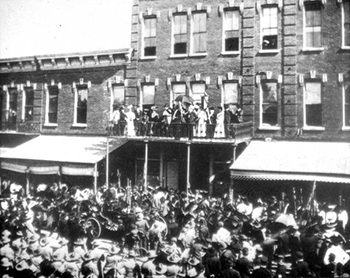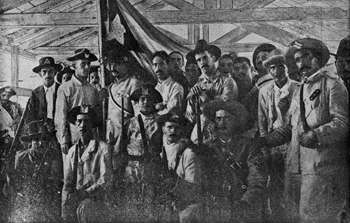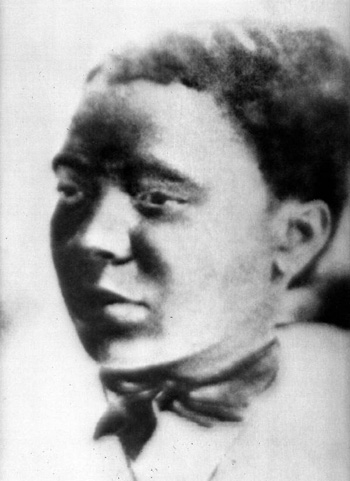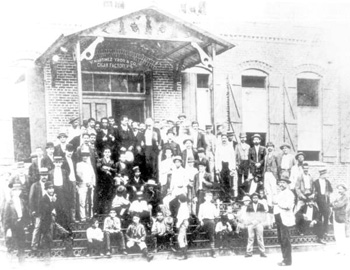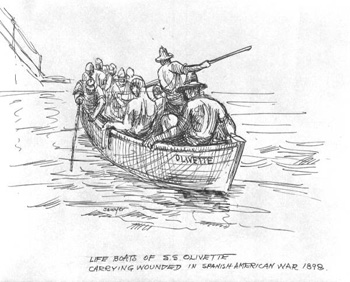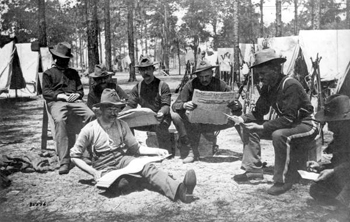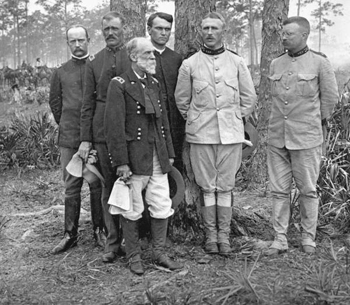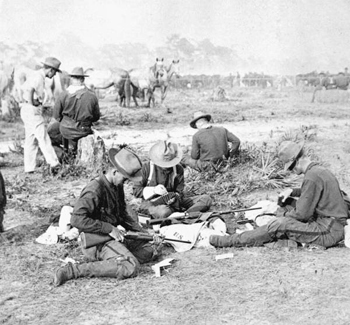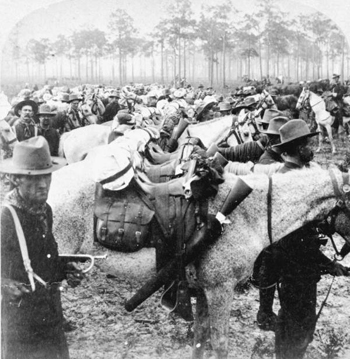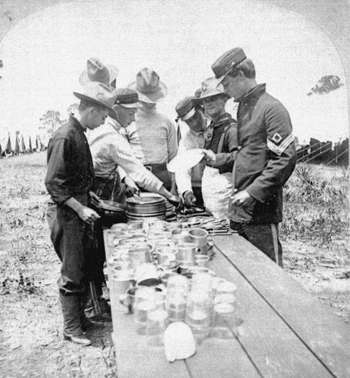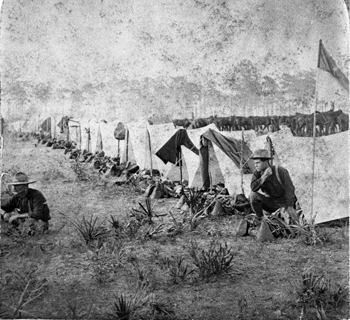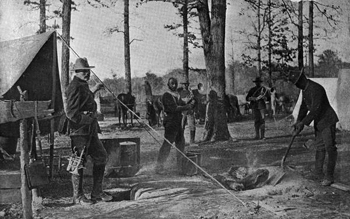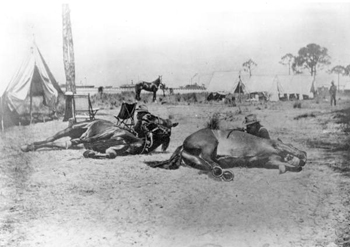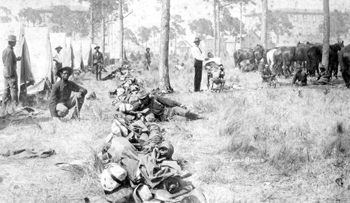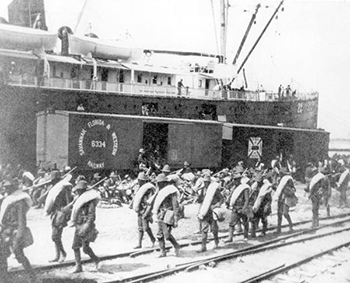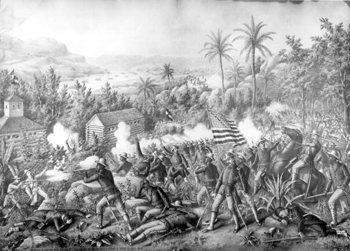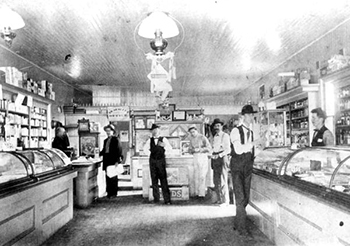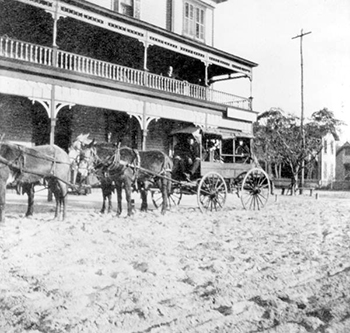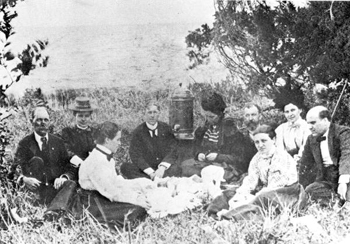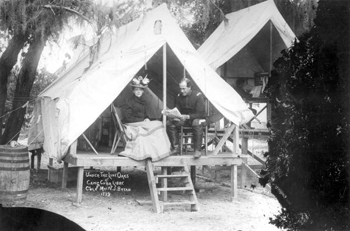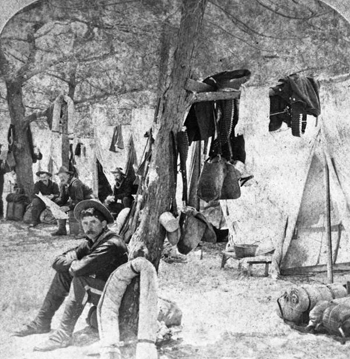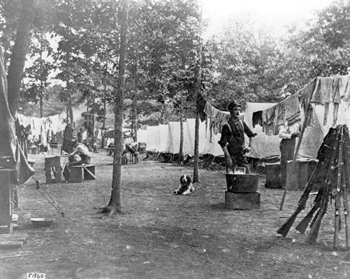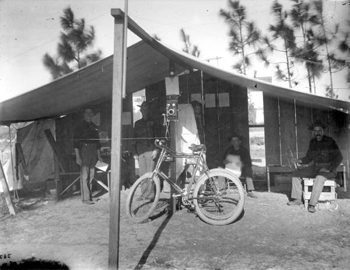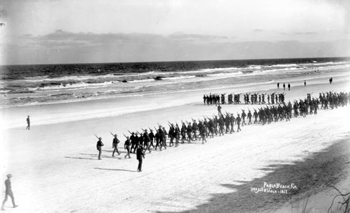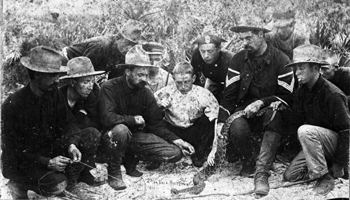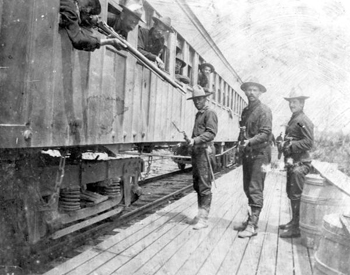Florida and the Spanish-American War of 1898
Photos and History
The United States Joins the Fight (April 25 - August 12, 1898)
The Spanish-American War, in which the United States became involved in Cuba’s war for independence from Spain, lasted less than four months. It began on April 25 and ended on August 12, 1898.
Cuba had been fighting for independence for 30 years. The American public followed years of news reports about the brutal fighting and Spanish atrocities.
An American battleship stationed off the Cuban coast, the USS Maine, exploded on February 15, 1898. Newspapers and officials who favored war with Spain insisted the Spanish were responsible, but the cause has never been definitively explained. The outcry from the American public and the United States government increased support for a war against Spain.
Man giving speech to the troops in Tampa, Florida (1898)
Image Number: N043493
The Florida Cigar Industry and the Cuban Revolution
Many Cuban and Spanish business owners chose to relocate their factories to Florida in the 1860s and 1870s, the early years of the Cuban Revolution. Florida's Cuban immigrants were strong supporters of the United States' involvement in the Spanish-American War.
Cuban-Americans from every social and economic level supported the cause of Cuban independence. Workers’ groups formed support organizations and workers conducted fundraising efforts. They supplied a continuous flow of money to support the revolution.
Cubans and Cuban-Americans in Florida also helped generate greater American support for United States intervention. Revolutionary leader José Martí toured Ybor City, West Tampa and Key West, delivering speeches to large crowds wherever he went. Martí returned to Cuba in 1895 to join the revolution.
Cuban volunteers in the barracks (1898)
Image Number: N041306
Caption: "Cuban volunteers in their barracks. Many of these were cigar makers at Tampa."
The "Army of the Cuban Republic" was made up of 40 Cubans from Jacksonville, 200 from New York, and 150 from Key West. They set sail on the Florida to join the rebels on May 21. Some of the volunteers are pictured here.
Paulina Pedroso (ca. 1898)
Image number: N043603
From the 1880s to 1910, Paulina Pedroso and her husband Ruperto worked at cigar making while organizing La Sociedad Libres on behalf of Cuban freedom. José Martí headquartered his United Statesactivities in the in her home in Ybor City.
José Martí at the Vicente Martinez Ybor cigar factory, where he made one of his most famous speeches for Cuban independence: Ybor City, Florida (between 1890 and 1895)
Image number: RC07469
José Martí is in the center of the photograph. He is standing on the top step with his jacket open and his hands in his pockets. This photographs was taken on the iron steps of the Vicente Martinez Ybor cigar factory, where Martí made one of his most famous speeches to supporters of the Cuban revolutionary movement.
Olivette lifeboat carrying wounded in Spanish-American War, 1898, drawn by Philip Ayers Sawyer
Image number: N047356
The Olivette brought tobacco out of Cuba for Tampa cigar factories until the U.S. government instituted an embargo on Cuban goods. The Olivette carried the survivors of the Maine back to the United States and helped evacuate American citizens from Cuba.
Debate and Dissent
Some Floridians supported war against Spain because they believed Cuba might eventually become a territory of the United States. Others supported U.S. intervention for humanitarian reasons. Telegrams and letters poured into the Governor’s office from citizens offering their services in the event of war.
Other Floridians did not strongly support U.S. action in Cuba. They did not want Cuba to become part of the United States. Sugar cane and tobacco from Cuba could compete with crops grown in Florida. Also, a number of the cigar factories were owned by Cuban-Americans of direct Spanish descent who did not support the war.
Company E of the Ninth Infantry reading newspapers during the Spanish-American War: Tampa, Florida (1898)
Image Number: RC06658
Theodore Roosevelt and the Rough Riders
Theodore Roosevelt led the most famous unit fighting in Cuba, the First U.S. Volunteer Cavalry, known as the “Rough Riders.” They were a diverse group including Native Americans, Ivy League athletes, Texas Rangers, cowboys and gold prospectors.
The Rough Riders went to Tampa at the end of May 1898. On June 13, they left Tampa to fight in Cuba. Two years after the end of the war, Roosevelt went on to become the 26th president of the United States.
Group portrait of Colonel Theodore Roosevelt and other high ranking officials of the 1st U.S. Volunteer Cavalry Regiment: Tampa, Florida (1898)
Image Number: PR10255
Left to Right: Major George Dunn, Major Alexander Brodie, Major General Joseph Wheeler, Chaplain Henry A. Brown, Colonel Leonard Wood, Colonel Theodore "Teddy" Roosevelt (future 26th U.S. President).
Rough Riders filling belts with cartridges (1898)
Image Number: PR10240
Captain Curry of the Rough Riders: Tampa, Florida (1898)
Image Number: PR10253
Tampa Changes from a Small Town into a City
Most of the United States troops heading to fight in Cuba went through Tampa. Theodore Roosevelt was there with his Rough Riders cavalry unit. Over 30,000 troops came to Tampa. Staging for the Spanish-American War changed Tampa from a small town into a city.
Company D Florida volunteers at dinner: Tampa, Florida (1898)
Image Number: PR10231
Street of Company E at the Rough Riders' camp in Tampa, Florida (1898)
Image Number: N041291
African-American Soldiers
The African-American community debated the role of black soldiers in the war. Many black people saw this as an opportunity to fight for equality at home by fighting oppression in Cuba. Others questioned whether African-Americans should fight for a U.S. government that enacted federal and state laws that deprived them of their rights.
The most famous of the African-American soldiers to fight in the Spanish-American War were known as the "Buffalo Soldiers." They were the first peacetime all-black regiments in the regular U.S. Army. Congress created the four regiments, the 9th and 10th Cavalries and the 24th and 25th Infantries, just after the American Civil War.
All four regiments were transferred to Florida in the spring of 1898 to prepare for the war with Spain. From Florida they went to Cuba, where black troops fought and played a major role in the victory at Santiago de Cuba.
Cooking for the Ninth U.S. Cavalry (1898)
Image Number: N041307
Ninth United States Calvary training horses for Spanish-American War (1898)
Image Number: RC20112
Camp barber at work during the Spanish-American War (1898)
Image Number: RC13589
10th U.S. Cavalry embarking for Cuba: Port Tampa, Florida
Image Number: RC06659
The Battle of Quasimas, near Santiago, June 24, 1898; the 9th and 10th Colored Calvary in support of Rough Riders (1898)
Image Number: RC10398
Lakeland, Florida
Lakeland was a staging area for troops en route to Cuba. It was chosen as an overflow site for Tampa, 30 miles to the west, because of its good rail connections and reliable water supply from area lakes. The addition of 9,000 troops to a town of 1,000 permanent residents created logistical problems and tension between citizens and soldiers.
John E. Lewis, a soldier in the 10th Cavalry, described a clash between black soldiers of the 10th Cavalry and local white business owners over the city's Jim Crow laws.
Interior view of a drugstore: Lakeland, Florida (ca. 1900)
Image Number: RC18218
The Typhoid Epidemic in the Spanish-American War
During the war, more soldiers died from disease than from combat wounds. Typhoid fever, a preventable disease transmitted through unsanitary conditions, was the major killer during the war.
Fever wards at the division hospital: Jacksonville, Florida (1898)
Image Number: N041310
Red Cross ambulance in Tampa during the Spanish-American War (1898)
Image Number: RC07098
Women as Nurses
Typhoid fever epidemics in the camps quickly overwhelmed the few qualified medical personnel that existed. Congress authorized the U.S. Army to hire men and women as nurses. Military officials appointed over one thousand women as nurses on a contract basis. Women served in Cuba, Puerto Rico, the Philippines, Hawaii and in camp hospitals in the United States. Recognition of the importance of hygiene and health after the Spanish-American War led to the establishment of the Army Nurse Corp.
Clara Barton and Red Cross colleagues having a picnic: Tampa, Florida (1898)
Image Number: RC13693
Clara Barton of the Red Cross waited in Tampa for permission to go to Cuba in order to bring medical supplies and care for wounded soldiers.
Jacksonville, Key West and Around the State
Florida became the staging area for war preparations. American volunteer soldiers camped and drilled in Jacksonville, Tampa, Key West and other locations around the state as they prepared to leave for Cuba. Key West served as a headquarters for the U.S. Navy. Other ships left Florida ports to carry troops and supplies for the brief war.
Colonel and Mrs. William Jennings Bryan in a tent under the live oaks: Jacksonville, Florida
Image Number: RC02394
Sultry day in camp: Tampa, Florida (1898)
Image Number: N041294
Spanish-American War camp scene: Tampa, Florida (1898)
Image Number: RC03722
Signal Corps telegraph and telephone office: Jacksonville, Florida (1898)
Image Number: RC06498
3rd Nebraska Volunteers marching on the beach: Pablo Beach, Florida (1898)
Image Number: RC03606
2nd Virginia Volunteers playing with a rattlesnake: Pablo Beach, Florida (1898)
Image Number: N041287
The rattlesnake appears to be a large diamondback, with 11 buttons on its tail.
Soldiers of the 2nd Regiment of Louisiana Volunteers at train depot: Cocoa, Florida (June 1898)
Image Number: RC06028
The End of the War and the Treaty of Paris
Once United States forces joined the Cuban revolutionaries, Spain was quickly defeated. The United States and Spain signed the Treaty of Paris on December 10, 1898. This treaty formally ended the Spanish-American War.
In the treaty, Spain ceded the islands of Puerto Rico and Guam to the United States. Spain also granted independence to Cuba and sold the Philippines to the United States for $20,000,000.
Before the war began, Congress had passed a law that prohibited the U.S. from annexing Cuba. Americans remained on the island, however, until the new Cuban government agreed to certain conditions. The Platt Amendment granted the U.S. the right to intervene in Cuban affairs and maintain naval bases. The U.S. still has a naval base in Cuba at Guantanamo Bay.
The Franklin D. Roosevelt administration repealed most of the Platt Amendment’s provisions in 1934. The United States still remained closely involved in Cuban affairs for decades afterward.

 Listen: The World Program
Listen: The World Program